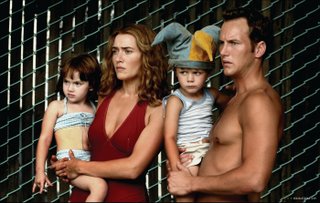 Yes, it’s true that "Dreamgirls" is very good musical; perhaps the best since "Chicago." Of course with films since then such as "Phantom of the Opera," "Rent" and "The Producers" that’s not exactly saying a lot. "Dreamgirls," which was written and directed by Bill Condon (who wrote the Oscar-nominated "Chicago" screenplay), is a movie musical that can be enjoyed by those who don’t know anything about the Broadway show; myself included. When I first heard of the film I assumed "Dreamgirls" was an original piece, however I learned that it was an early ‘80s musical loosely based on the rise of Diana Ross & the Supremes. It has a jazzy R&B sound that employs many talented voices and an intriguing, although not altogether original, story.
Yes, it’s true that "Dreamgirls" is very good musical; perhaps the best since "Chicago." Of course with films since then such as "Phantom of the Opera," "Rent" and "The Producers" that’s not exactly saying a lot. "Dreamgirls," which was written and directed by Bill Condon (who wrote the Oscar-nominated "Chicago" screenplay), is a movie musical that can be enjoyed by those who don’t know anything about the Broadway show; myself included. When I first heard of the film I assumed "Dreamgirls" was an original piece, however I learned that it was an early ‘80s musical loosely based on the rise of Diana Ross & the Supremes. It has a jazzy R&B sound that employs many talented voices and an intriguing, although not altogether original, story.Perhaps the headline of the year is the breakout performance of American Idol contestant Jennifer Hudson. The finalist scores the role of a lifetime as Effie, whose emotions and dreams get stomped on when she’s forced out of a smalltown1960s female R&B group (The Dreams). Like big stars before her, she’s destined for big things, but she’ll have to wait until the third act before she gets any hope of her dreams being fulfilled. The other two members of the talented trio are Deena (Beyoncé Knowles) and Lorrell (Anika Noni Rose). Oscar-winner Jamie Foxx becomes the girls’ manager and before you can say Gladys Knight & The Pips, stardom comes their way. Hudson is definitely the standout here, and while she’s not the best actress to ever grace the silver screen, it's impossible to deny the sheer emotional power that she emulates during her song numbers. She moved the audience I was in to tears and thunderous applause; in the middle of the film!
Yes the story is something that been seen countless times before: small town singers hit it big and obsession with fame gets the best of them. But Condon tells his story in such a flashy, entertaining way that you never realize you’ve actually heard it all before. He’s skilled at making the song numbers catchy and engaging, while letting it all make sense. Yes there are times when characters breakout in song, (during catfights, no less) but most of the music takes place on stage or in the recording studio. This is truly a beautifully filmed vision of dreaming big and achieving big time success.
And who could talk about “Dreamgirls” without mentioning the return to form of Eddie Murphy? While I’m not exactly Murphy’s biggest fan, I know talent when I see it and he’s got it. He slips easily into the role of aging Motown star James “thunder” Early. Murphy can actually sing despite having previously recorded “Party All the Time” way back in the ‘80s.
"Dreamgirls" is a well crafted movie musical, with performers and filmakers in top form, that sweeps you up and entertains for its entire running time. It’ll be interesting to see how it does come Oscar time, and while it’s not one the best films of year, you really don’t need to look much further to find such a winning time at the multiplex. GRADE: B+






















